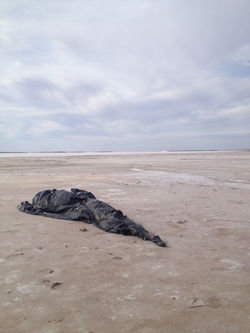SAM TRUBRIDGE PERFORMANCE ART
NIGHT WALK
A performance work and process conducted as a blind navigation with the landscape, as part of an ongoing study into nomadic states. A large sphere of inflated black plastic is inhabited by a walker. The sphere’s movement through various terrains perforates the thin plastic, creating a constellation of pinpricks that afford the invisible walker within a mapping system to navigate by. These acts of blind navigation produce a dialogue with each terrain, encountering surfaces, materials, spatial qualities, rhythms, and other movement systems. A dark intrusion occurs that creates alternative, non-linear, fluid narratives in relation to landscapes. The condition of blindness reveals tensions between the body and the geological, geographic, cultural, technological, and architectural terrains encountered.
In the Australian context, walking country has particular significance as a mode of culturally-located knowing, resonant with the ‘songlines’ of Aboriginal tradition. Starting in this ‘storied terrain’ of the Australian continent, the work performs as an autopoetic register of intersections between mobile spatial practices, non-linear narratives, and the organisational fixity of the state polis and urban architecture.
Following an experimental journey in the Murray Riverland, Night Walk journeyed through city spaces in relation to the two Performing Mobilities gallery sites. Temporarily lodging in thresholds of the galleries and their spaces within, this nomadic object unsettled the architecture of the gallery with a provisional spatiality.
In collaboration with Culpra Milli Aboriginal Corporation
Interpretive Wonderings symposium / Culpra Station, Victoria, Australia / 13-14 September 2015
Performing Mobilities symposium / RMIT and VCA Galleries, Melbourne, Australia / 26 September - 23 October 2015
The Performance Series 2015 / 30Upstairs Gallery, Wellington, NZ / 20-28th November 2015
Interpretive Wonderings exhibition / Mildura Arts Centre, Victoria, Australia / 20 February - 10 April 2016
Pah Homestead / Auckland, NZ / 5-19 November 2018
The Prague Quadrennial / Prague, Czechia / 6-16 June 2019
UP-ON Live Art Festival / Chengdu, China / 19-20 October 2023
 |  |  | 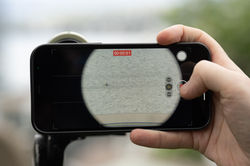 |
|---|
PENELOPE'S WINDOW
Three telescopes are mounted outside the gallery - pointed at the harbour below. Each of them has a pair of headphones attached. By looking through the telescope, audiences can watch a figure rowing a little boat in tight circles in the bay. A book faces them in the stern of the rowing boat.
Through the earphones the audience can listen to rower reading aloud from Homer's Odyssey. In future iterations other texts could also be used to engage with the specifics of each location: such as the journals of Captain Cook or Abel Tasman and letters home from their travels, whatever allows the work to implicate archetypes of the pakeha male explorer and voyager.
The work examines male absence, adventure, futility, and a preoccupation with the sublime. It reduces the performing figure to a tiny shape labouring in the harbour and travelling in circles. The work also explores embodied performance seen over a long distance – using view-finding devices and the site of colonial 18th century gravestones to frame the experience.
Read a review by Quinoa / Chris Kirk for Rat World Magazine here
Performance Art Week Aotearoa, Wellington, Aotearoa NZ / 2-4 November 2023
MANY BREATHS (TO LIFT AN ANCHOR FROM THE SEA BED)
An anchor is a boat’s connection with the earth through the sea-floor. It creates a link between the floating fluid state above and the safety and security of terra firma below: holding a boat fast in storms, and keeping it in harbour. This work attempts to use a collective action to retrieve an anchor that has lain on the Long Island seabed for many years, covered in coral and weed. Deep Anatomy participants and members of the island community were be invited to fill plastic bubbles with their breath and attach them to a growing cluster of bubbles affixed to its shank. Thus, piece by piece, the individual breaths would lift the anchor from the sea-bed and return it to the surface.
The 2015 performance succeeded in lifting the anchor to the surface, at which point the attachment broke and the anchor sank back down. The performance was repeated in 2017 using the nose-cone of spaceship wreckage to float the anchor, which was also unsuccessful. A second performance in 2017 used salvage bags, and succeeded as planned. A video installation of the three iterations was shown in an exhibition in Auckland, Aotearoa NZ later in 2017.
We shall go to sea my brother
Where three years hence an anchor lay
Past coral gardens on soft blue sand
In fathoms nine
Where sharks patrol and stingrays play
Breathe deep, my mother’s other son
Let us raise this arrow, this hook, this ship’s tether, from its rest
Lift this anchor from the sea’s deep bed
Hang it from a cloud of divers’ breath
Let it bob upon the swell awhile
Before its weight pulls it back to sleep
Let it fall from the light and waves
Let it plummet to the deep
Home again beneath the sea once more
Home again on the ocean’s breast
Deep Anatomy, a regional cluster for the PSi21 Fluid States project / Long Island, The Bahamas / 9 May 2015
Deep Anatomy exhibition, Silo Park, Auckland, Aotearoa 2017
 | 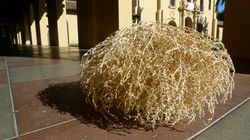 |  |  |  |
|---|---|---|---|---|
 |  |  |  |  |
 |  |  |
SPACE INVADERS
Space Invaders has its origins in two projects: the performance production Ecology in Fifths, and participation in the Shuttle Mobile Performance Laboratory. It was first presented in Stanford University for PSi#19 with artists from the Shuttle project, where the work responded to the specifics of the American cultural landscape and the unwelcome ‘ingress’ of alien cultures and estranged bodies into suburban ecologies: migrant workers, border-crossing Mexicans, and the Russian Thistle / Salsala Targus (tumbleweed).
This ongoing work responds to specific local narratives associated with displacement, colonization, and the environment. In each iteration, new objects are substituted for the tumbleweed, and new associations are brought into the design in order to engage ecological and cultural concerns specific to that landscape, time, or event. The most recent presentation at 30Upstairs used the road-worker’s uniform to authorise an action that was unauthorised by the city council, or any other authority other than my own. This revealed similar tensions to those experienced at Stanford University, where occupancy of public space becomes highly regulated, and is associated with lower status, gypsy or squatting practices.
PSi19 'Now Then: performance and temporality' / Stanford University, Palo Alto, California, USA / 26-30 June 2013
The Performance Series 2014 / 30Upstairs Gallery, Wellington, New Zealand / 8-9 December 2014
 | 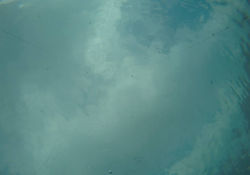 |  |  |
|---|
SUBDIVISION
Referencing Borges’ story of the emperor’s map, and Baudrillard’s philosophical analysis of this text, this work casts a meticulous grid over the shifting seascape that it occupies. Threaded on invisible lengths of fishing line and spaced at intervals of exactly 1 metre, 350 small plastic 'pearls' were floated just under the surface of the water in Rijeka's harbour. As the tide reached its full ebb they appeared to almost reach the surface, but never quite did. Arranged with mathematical precision over 50x7m, this grid of dots undulated with the swell, attempting to map or colonise the unfixed, transient nature of the sea with the rigidity of land-based navigational systems and agricultural subdivision. It is polemic and poetic at the same time: casting a shallow ‘net’ that reveals deeper, submarine ecologies, hydrological movements, and environmental concerns about the space. It also examines, in a semi-satirical fashion, the exhausting, absurd, and doomed preoccupation with applying land-based (terrestrial) two-dimensional mapping conventions into a complex, four-dimensional environment.
Zooming Fluid States Festival / Rijeka, Croatia / 9 September 2014
 |  |  |  |
|---|
SLEEPLESS
(with sleep scientist Philippa Gander)
ISleepless explored a germinal concept from the SLEEP/WAKE theatre production: that as the opposite of performance, sleep is inherently un-performable. Our intention was to explore this challenge: I would attempt to ‘perform’ sleep whilst while attached to the polysomnographic equipment used in sleep studies. This technology uses electrodes attached to various locations on the subject’s head to measure the activities in the cortex (the part of the brain that is most active in waking states) as well as eye movements, and movements in the chin muscles. In the ‘performance space’, data projectors were used to cast this polysomnographic information onto a screen positioned behind the bed - exposing the inner workings of my attempt to sleep over the duration of each exhibition.
Sleepless I presented in 2009 at Centro de Ciencias de Benasque Pedro Pascual, Spain for ‘Art and Science: exploring the limits of human perception’ conference
Sleepless II presented in 2009 at ‘Glitch, performance and media art event’ at St Paul Street Gallery, AUT, Auckland
Sleepless III: Transgressions presented in 2010 at the 35th Annual Meeting for the Brazilian Society of Neuroscience and Behaviour, Caxambu, Brazil.
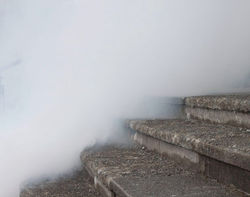 |  |  |  |  |
|---|
TIME CAPSULE
(with Rob Appierdo and Stuart Foster)
A message from tomorrow, Time Capsule occupied a time zone ahead of most of the presenters participating in the Low Lives 2 International Internet Festival of Performance Art, curated by US based Jorge Rojas. The work was installed outside The Old Museum and National War Memorial in Wellington, New Zealand. Passers by asked to state the date and time before providing a short verbal message in response to the question “What would you like to tell the past?” Meanwhile, numerous smoke machines and hazers hidden in the architecture filled the space with billows of smoke and mist, thus turning the space into a ghostly, otherworldly cityscape that suggested an indeterminate, or slightly precarious future. The work was a play on the distance that currently persists between different time zones and cultures, provoking contemplation on the attitudes that cause us to disregard the livelihood of future generations and geographically distanced communities.
Low Lives 2 / The Old Museum Building, Wellington, New Zealand / 1 May 2010
View video here: Time Capsule








